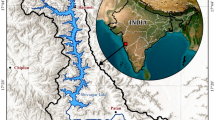Abstract
Flash point is a primary property used to determine the fire and explosion hazards of a liquid. New group contribution-based models were presented for estimation of the flash point of alkanes by the use of multiple linear regression (MLR) and artificial neural network (ANN). This simple linear model shows a low average relative deviation (AARD) of 2.8% for a data set including 50 (40 for training set and 10 for validation set) flash points. Furthermore, the predictive ability of the model was evaluated using LOO cross validation. The results demonstrate ANN model is clearly superior both in fitness and in prediction performance. ANN model has only the average absolute deviation of 2.9 K and the average relative deviation of 0.72%.
Similar content being viewed by others
References
National Fire Protection Agency. Fire protection guide on hazardous materials [M]. 10th ed. Quincy: NFPA, 1991.
KATRITZKY A R, STOYANOVA-SLAVOVA I B, DOBCHEV D A, KARELSON M. QSPR modeling of flash points: An update [J]. J Mol Graph Model, 2007, 26: 529–536.
JONES J C, GODEFROY J. A reappraisal of the flash point of formic acid [J]. J Loss Prev Process Ind, 2002, 15: 245–247.
SUZUKI T, OHTAGUCHI K, KOIDE K. A method for estimating flash points of organic compounds from molecular structures [J]. J Chem Eng Jpn, 1991, 24: 258–261.
KESHAVARZ M H, GHANBARZADEH M. Simple method for reliable predicting flash points of unsaturated hydrocarbons [J]. J Hazard Mater, 2011, 193: 335–341.
PAN Y, JIANG J, WANG Z. Quantitative structure-property relationship studies for predicting flash points of alkanes using group bond contribution method with back-propagation neural network [J]. J Hazard Mater, 2007, 147: 424–430.
DAI Yi-min, LI Xun, CAO Zhong, YANG Dao-wu, HUANG Ke-long. Modeling flash point scale of hydrocarbon by novel topological electro-negativity indices [J]. The Chemical Industry and Engineering Society of China Journal, 2009, 60(10): 2420–2425. (in Chinese)
KATRITZKY A R, KUANAR M, SLAVOV S, HALL C D, KARELSON M, KAHN I, DOBCHEV D A. Quantitative correlation of physical and chemical properties with chemical structure: Utility for prediction [J]. Chem Rev, 2010, 110: 5714–5789.
LIU X, LIU Z. Research progress on flash point prediction [J]. J Chem Eng Data, 2010, 55: 2943–2950.
Hazardous Chemicals data. NFPA49. PC-49-94 [OB/OL]. [1994] http://ull.chemistry.uakron.edu/erd/index.html.
GHARAGHEIZI F, ESLAMIMANESH A, ILANI-KASHKOULI P, RICHON D, MOHAMMADI A H. QSPR molecular approach for representation/prediction of very large vapor pressure dataset [J]. Chem Eng Sci, 2012, 76: 99–107.
ZHOU C Y, NIE C M, LI S, LI Z H. A novel semi-empirical topological descriptor Nt and the application to study on QSPR/QSAR [J]. J Comput Chem, 2007, 28: 2413–2423.
BAGHERI M, GANDOMI A H, GOLBRAIKH A. Simple yet accurate prediction method for sublimation enthalpies of organic contaminants using their molecular structure [J]. Thermochim Acta, 2012, 543: 96–106.
GRAMATICA P. Principles of QSAR models validation: Internal and external [J]. QSAR & Combinatorial Science, 2007, 26: 694–701.
DUCHOWICZ P R, CASTRO E A, FERNANDEZ F M, GONZALEZ M P. A new search algorithm for QSPR/QSAR theories: normal boiling points of some organic molecules [J]. Chem Phys Lett, 2005, 412: 376–380.
DAI Yi-min, LIU You-nian, LI Xun, CAO Zhong, ZHU Zhi-ping, YANG Dao-wu. Estimation of surface tension of organic compounds using QSPR [J]. Journal of Central South University, 2012, 19(1): 93–100.
BAGHERI M, BORHANI T N G, ZAHEDI G. Estimation of flash point and autoignition temperature of organic sulfur chemicals [J]. Energy Convers Manage, 2012, 58: 185–196.
DAI Yi-min, HUANG Ke-long, LI Xun, CAO Zhong, ZHU Zhi-ping, YANG Dao-wu. Simulation of 13C NMR chemical shifts of carbinol carbon atoms by using quantitative structure-spectrum relationships [J]. Journal of Central South University of Technology, 2011, 18(2): 323–340.
GHARAGHEIZI F. Prediction of upper flammability limit percent of pure compound from their molecular structures [J]. J Hazard Mater, 2009, 167: 507–510.
ROY K, KABIR H. QSPR with extended topochemical atom (ETA) indices: Exploring effects of hydrophobicity, branching and electronic parameters on logCMC values of anionic surfactants [J]. Chem Eng Sci, 2013, 87: 141–151.
ERIKSSON L, JAWORSKA J, WORTH A P, CRONIN M T D, MCDOWELL R M, GRAMATICA P. Methods for reliability and uncertainty assessment and for applicability evaluations of classification and regression-based QSARs [J]. Environ Health Perspect, 2003, 111: 1361–1375.
PAN Y, JIANG J, WANG R, CAO H Y, CUI Y. A novel QSPR model for prediction of lower flammability limits of organic compounds based on support vector machine [J]. J Hazard Mater, 2009, 168: 962–969.
VAZHEV V V, ALDABERGENOV M K, VAZHEVA N V. Estimation of flash points and molecular masses of alkanes from their IR spectra [J]. Petrol Chem, 2006, 46: 136–139.
ALBAHRI T A. Flammability characteristics of pure hydrocarbons [J]. Chem Eng Sci, 2003, 58: 3629–3641.
Author information
Authors and Affiliations
Corresponding authors
Additional information
Foundation item: Projects(21376031, 21075011) supported by the National Natural Science Foundation of China; Project(2012GK3058) supported by the Foundation of Hunan Provincial Science and Technology Department, China; Project supported by the Postdoctoral Science Foundation of Central South University, China; Project(2014CL01) supported by the Foundation of Hunan Provincial Key Laboratory of Materials Protection for Electric Power and Transportation, China; Project supported by the Innovation Experiment Program for University Students of Changsha University of Science and Technology, China
Rights and permissions
About this article
Cite this article
Dai, Ym., Liu, H., Chen, Xq. et al. A new group contribution-based method for estimation of flash point temperature of alkanes. J. Cent. South Univ. 22, 30–36 (2015). https://doi.org/10.1007/s11771-015-2491-0
Received:
Accepted:
Published:
Issue Date:
DOI: https://doi.org/10.1007/s11771-015-2491-0




